
Sonic & Knuckles is a 1994 platform game developed and published by Sega. Players control Sonic the Hedgehog and Knuckles the Echidna in their quests to save Angel Island; Sonic tries to stop Doctor Robotnik from re-launching his orbital weapon, the Death Egg, while Knuckles scuffles with Robotnik's minion, EggRobo. Like previous Sonic games, players traverse side-scrolling levels at high speeds while collecting rings and defeating enemies.

Sonic Advance, known as SonicN on the N-Gage, is a 2001 platform game developed by Dimps and published by Sega for the Game Boy Advance. It was the first Sonic the Hedgehog game released on a Nintendo console with Sonic Adventure 2: Battle on the GameCube, and was produced in commemoration of the series' tenth anniversary. The story follows Sonic, Tails, Knuckles, and Amy as they journey to stop Doctor Eggman from taking over the world. Controlling a character, players are tasked with completing each level, defeating Eggman and his robot army, and collecting the seven Chaos Emeralds.
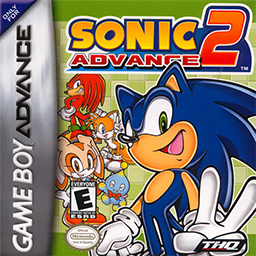
Sonic Advance 2 is a 2002 platform video game developed by Dimps and published by Sega for the Game Boy Advance. It is an installment in the Sonic the Hedgehog series and the sequel to 2001's Sonic Advance. The story follows Sonic as he sets out to save his friends and retrieve the seven magical Chaos Emeralds from Dr. Eggman. Gameplay consists of the player completing various levels as one of five characters, each with their own unique attributes. After each zone is completed, the player faces Dr. Eggman in a boss battle.

Sonic the Hedgehog Spinball, also known as Sonic Spinball, is a 1993 pinball video game developed by Sega Technical Institute and published by Sega. It is a spinoff of the Sonic the Hedgehog series. Players control Sonic the Hedgehog, who must stop Doctor Robotnik from enslaving the population in a giant pinball-like mechanism. The game is set in a series of pinball machine-like environments with Sonic acting as the pinball.

Sonic the Hedgehog: Triple Trouble is a 1994 platform game developed by Aspect and published by Sega for the Game Gear. It is the sequel to Sonic Chaos (1993) and features classic side-scrolling Sonic gameplay. The player controls either Sonic the Hedgehog or Miles "Tails" Prower as they venture to protect the powerful Chaos Emeralds from Doctor Robotnik, Knuckles the Echidna, and series newcomer Nack the Weasel. Sonic and Tails' unique abilities, as well as various power-ups, can assist the player in gameplay.
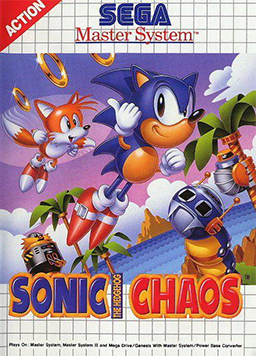
Sonic Chaos is a 1993 platform game published by Sega for the Master System and Game Gear. Players control Sonic the Hedgehog and his sidekick Miles "Tails" Prower in their quest to retrieve the Chaos Emeralds from Doctor Robotnik, who has stolen them to construct nuclear weapons. Gameplay involves running through stages, collecting rings, and defeating enemies. It is largely based on the Master System version of Sonic the Hedgehog 2, and is thus considered a follow-up to that game. Chaos is the first Sonic game for the Master System and Game Gear to feature Tails as a separate playable character with his own unique abilities.

Sonic the Hedgehog 2 is a 1992 platform game developed by Aspect and published by Sega for the Master System and Game Gear. It is the sequel to the 8-bit Sonic the Hedgehog (1991) and follows Sonic as he attempts to get the Chaos Emeralds back to rescue his friend Miles "Tails" Prower from Dr. Robotnik. Like the first Sonic the Hedgehog, players run through levels at high speeds while collecting rings and defeating enemies. Although it shares the same title with Sonic the Hedgehog 2 for the Sega Genesis and their releases coincided, the games have little in common and share no levels.

Sonic the Hedgehog is a video game series and media franchise created by the Japanese developers Yuji Naka, Naoto Ohshima, and Hirokazu Yasuhara for Sega. The franchise follows Sonic, an anthropomorphic blue hedgehog who battles the evil Doctor Eggman, a mad scientist. The main Sonic the Hedgehog games are platformers mostly developed by Sonic Team; other games, developed by various studios, include spin-offs in the racing, fighting, party and sports genres. The franchise also incorporates printed media, animations, feature films, and merchandise.

Sonic and the Secret Rings is a 2007 platform video game developed by Sonic Team and published by Sega for the Wii. A spin-off from the Sonic the Hedgehog series, it is the first title in the franchise for the system, and follows Sonic the Hedgehog's quest to stop an evil genie named the Erazor Djinn. In addition to the basic platforming gameplay of previous Sonic titles, Secret Rings uses a system of experience points and levels, as well as special moves that are unlocked by means of progression.

Mario & Sonic at the Olympic Games is a 2007 crossover sports and party game developed by the Sega Sports R&D Department. It is the first installment on the Mario & Sonic series. It was published by Nintendo in Japan and by Sega in other regions, and released on the Wii in November 2007 and the Nintendo DS handheld in January 2008. The first official video game of the 2008 Summer Olympic Games, it is licensed by the International Olympic Committee (IOC) through exclusive licensee International Sports Multimedia (ISM), and is the first official crossover game to feature characters from both the Mario and Sonic the Hedgehog series.

Nights: Journey of Dreams is an action video game developed by Sega Studios USA and published by Sega for the Wii. The sequel to the 1996 Sega Saturn title Nights into Dreams, it was released in Japan and North America in December 2007, and in Australia and Europe the following month. The story follows two children, William Taylor and Helen Cartwright, who enter a dream world called Nightopia. When their nightmares come to life, they enlist the help of Nights, an exiled "Nightmaren", as they journey through Nightopia to stop the evil ruler Wizeman from escaping into the real world.
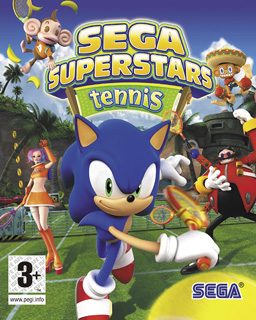
Sega Superstars Tennis is a sports video game developed by Sumo Digital and published by Sega. It is the second title in the Sega All-Stars series, preceded by Sega Superstars (2004), and crosses over characters, locations, and soundtracks from several Sega franchises, including Sonic the Hedgehog, Space Channel 5, and Super Monkey Ball.
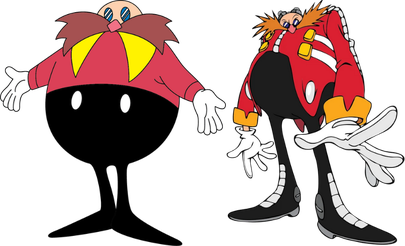
Doctor Ivo "Eggman" Robotnik is the main antagonist of Sega's Sonic the Hedgehog franchise. Eggman was created and designed by Naoto Ohshima as part of many design choices for Sega's new mascot. After the creation of Sonic the Hedgehog, Ohshima chose to use his previous egg-shaped character to create the antagonist of the 1991 video game Sonic the Hedgehog, making him the arch-nemesis of the series' eponymous main character.

Sonic Unleashed is a 2008 platform video game in the Sonic the Hedgehog series. The story follows Sonic as he attempts to restore the world after his nemesis Doctor Eggman shatters it with a powerful laser to unleash Dark Gaia, an ancient evil, while dealing with having become a "Werehog", a werewolf-like transformation, which he gains after coming into contact with the energy of Dark Gaia. Gameplay features two distinct styles, with each being played either during daytime or nighttime. Daytime stages incorporate Sonic's traditional platforming and trademark speed, with a combination of behind-the-back third-person viewpoints and 2D side-scroller platforming; gameplay seamlessly transitions between these two views. Night-time levels see Sonic transform into the Werehog; gameplay slows down to accommodate greater platform play, and involves combat against waves of enemies using the Werehog's brute strength.

Mario & Sonic at the Olympic Winter Games is a 2009 sports and party game developed by Sega. Like its predecessor, it was published by Nintendo for Japan and Korea and by Sega in the Western world. The game is officially licensed by the International Olympic Committee (IOC) through exclusive license International Sports Multimedia. The game is the third official crossover title to feature characters from both Mario and Sonic's respective universes, the first and second being the game's predecessor Mario & Sonic at the Olympic Games and Super Smash Bros. Brawl respectively. It was released on the Wii and the Nintendo DS in October 2009, and is the first official video game of the 2010 Winter Olympic Games.

Sonic Colors is a 2010 platform game published by Sega. It follows Sonic's quest to stop his nemesis Doctor Eggman from enslaving an alien race and taking over the world. The gameplay is similar to prior Sonic games, with players collecting rings and defeating enemies; the camera perspective often switches from third-person to side-scrolling perspectives. The game also introduces Wisps, power-ups the player can use to increase attack power and reach new areas.

Sonic the Hedgehog 4: Episode II is a 2012 episodic platform video game in the Sonic the Hedgehog series, and the sequel to Sonic the Hedgehog 4: Episode I. The game was developed by Dimps, with assistance from Sonic Team, and published by Sega. The game was intended to emulate the original Sonic the Hedgehog games on the Sega Genesis.

Sonic Lost World is a 2013 platform game developed by Sonic Team. It is part of the Sonic the Hedgehog series, and was released in October 2013 for the Wii U and Nintendo 3DS in PAL regions by Nintendo and by Sega in North America and Japan. A port of the Wii U version for Windows was later released in November 2015.

Sonic Boom: Rise of Lyric is a 2014 action-adventure platform video game developed by Big Red Button and published by Sega for the Wii U. Along with Sonic Boom: Shattered Crystal for the Nintendo 3DS, it is a spin-off of Sega's Sonic the Hedgehog series and is a part of the Sonic Boom franchise, which also consists of an animated television series, a comic series by Archie Comics, and a toyline by Tomy. The storyline follows Sonic, Tails, Knuckles and Amy, who must stop Lyric the Last Ancient from acquiring the Chaos Crystals by powering up a robot army and wiping out all organic life, after Sonic accidentally awakens Lyric from a thousand year rest, while escaping Doctor Eggman.
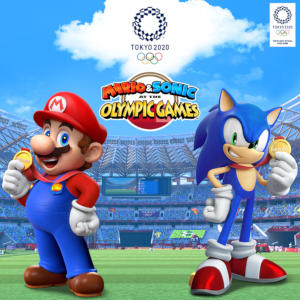
Mario & Sonic at the Olympic Games Tokyo 2020 is a 2019 sports video game based on the 2020 Summer Olympics. It is the sixth game in the Mario & Sonic series, a crossover between Nintendo's Super Mario and Sega's Sonic the Hedgehog franchises, and the first since the Rio 2016 Olympic Games edition. It was developed and published by Sega for the Nintendo Switch in November 2019 and for arcade cabinets in 2020.





















